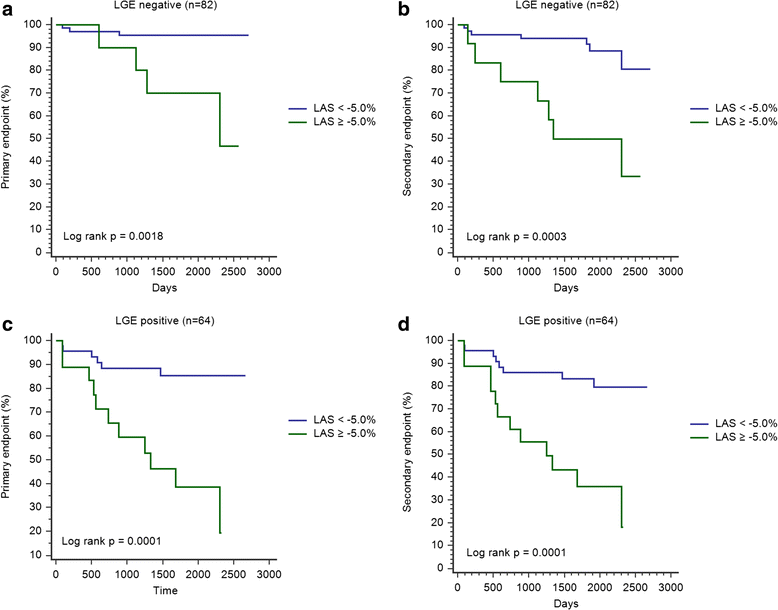Left ventricular long axis strain: a new prognosticator in non-ischemic dilated cardiomyopathy?
- PMID: 27268238
- PMCID: PMC4897821
- DOI: 10.1186/s12968-016-0255-0
Left ventricular long axis strain: a new prognosticator in non-ischemic dilated cardiomyopathy?
Abstract
Background: Long axis strain (LAS) has been shown to be a fast assessable parameter representing global left ventricular (LV) longitudinal function in cardiovascular magnetic resonance (CMR). However, the prognostic value of LAS in cardiomyopathies with reduced left ventricular ejection fraction (LVEF) has not been evaluated yet.
Methods and results: In 146 subjects with non-ischemic dilated cardiomyopathy (NIDCM, LVEF ≤45 %) LAS was assessed retrospectively from standard non-contrast SSFP cine sequences by measuring the distance between the epicardial border of the left ventricular apex and the midpoint of a line connecting the origins of the mitral valve leaflets in end-systole and end-diastole. The final values were calculated according to the strain formula. The primary endpoint of the study was defined as a combination of cardiac death, heart transplantation or aborted sudden cardiac death and occurred in 24 subjects during follow-up. Patients with LAS values > -5 % showed a significant higher rate of cardiac events independent of the presence of late gadolinium enhancement (LGE). The multivariate Cox regression analysis revealed that LVEDV/BSA (HR: 1.01, p < 0.05), presence of LGE (HR: 2.51, p < 0.05) and LAS (HR: 1.28, p < 0.05) were independent predictors for cardiac events. In a sequential cox regression analysis LAS offered significant incremental information (p < 0.05) for the prediction of outcome in addition to LGE and LVEDV/BSA. Using a dichotomous three point scoring model for risk stratification, including LVEF <35 %, LAS > -10 % and the presence of LGE, patients with 3 points had a significantly higher risk for cardiac events than those with 2 or less points.
Conclusion: Assessment of long axis function with LAS offers significant incremental information for the prediction of cardiac events in NIDCM and improves risk stratification beyond established CMR parameters.
Keywords: Cardiovascular magnetic resonance; Dilated cardiomyopathy; Left ventricular function; Long axis strain; Prognosis.
Figures





References
-
- Maron BJ, Towbin JA, Thiene G, Antzelevitch C, Corrado D, Arnett D, et al. Contemporary definitions and classification of the cardiomyopathies: an American Heart Association Scientific Statement from the Council on Clinical Cardiology, Heart Failure and Transplantation Committee; Quality of Care and Outcomes Research and Functional Genomics and Translational Biology Interdisciplinary Working Groups; and Council on Epidemiology and Prevention. Circulation. 2006;113:1807–16. doi: 10.1161/CIRCULATIONAHA.106.174287. - DOI - PubMed
Publication types
MeSH terms
Substances
LinkOut - more resources
Full Text Sources
Other Literature Sources
Miscellaneous

